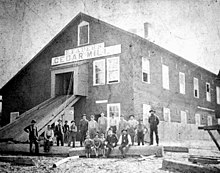Rosewood, Florida
Rosewood, Florida | ||
|---|---|---|
ZIP code 32625 | ||
| Area code | 352 | |
Rosewood is an
History
Settlement
Rosewood was settled in 1845, with its industry centered on timber, from
Two Black families in Rosewood named Goins and Carrier were the most influential. The Goins family brought the
Before the massacre
As was common in the late 19th century South, Florida had imposed legal racial segregation under Jim Crow laws, requiring separate Black and White public facilities and transportation.[6] Blacks and Whites created their own community centers: in 1920, the residents of Rosewood were mostly self-sufficient. They had three churches, a school, a large Masonic Hall, a turpentine mill, a sugarcane mill, a baseball team named the Rosewood Stars, and two general stores, one of which was White-owned. The village had about a dozen two-story wooden plank homes, other small two-room houses, and several small unoccupied plank farm and storage structures. Some families owned pianos, organs, and other symbols of middle-class prosperity. Survivors of the Rosewood massacre remember it as a happy place. In 1995 survivor Robie Mortin recalled at age 79, "Rosewood was a town where everyone's house was painted. There were roses everywhere you walked. Lovely."[7]
Etymology
The name "Rosewood" refers to the reddish color of cut
Economy
Before 1923

Rosewood was settled in 1845, 9 miles (14 km) east of
Decline of Rosewood's economy (1923–1950)
In 1923, during the infamous Rosewood massacre, the entire town of Rosewood was razed except for John Wright's General Store.[8] After the majority of the population fled Rosewood, the once profitable turpentine industry began to fade as newer, alternative synthetic products were being produced. By 1950, the turpentine industry practically no longer existed.[9]
Since 1950
Since the 1950s, several businesses were established in Rosewood, including a general store;
Rosewood Massacre
In January 1923, white men from nearby towns lynched Sam Carter allegedly in response to a claim that a white woman, Fannie Taylor, in nearby Sumner had been beaten and possibly raped by a Black drifter. When Black citizens defended themselves against further attack, several hundred Whites organized to comb the countryside hunting for Black residents and burned almost every structure in Rosewood. Survivors hid for several days in nearby swamps and were evacuated by train and car to larger towns. The local sheriff and the Governor refused to send aid, including the National Guard. Although state and local authorities were aware of the violence, they made no arrests for the activities in Rosewood. The town was abandoned by Black residents during the attacks. None ever returned.
Massacre reparations
In the spring of 1994, the Florida state legislature voted to award $2 million in compensation for the nine surviving family members (equaling $150,000 each). In December 2010, a state scholarship was established for descendants of families that survived the massacre.
Legal Issues
During the debate over Florida House Bill 591,
Community services
In 1980, the Rosewood Volunteer Fire Department was officially established and the station number was designated as 80 in District 4.[14]
Films
- Rosewood (1997)
References
- ^ Rosewood on Google Maps
- ^ Colburn, David R. (Fall 1997) "Rosewood and America in the Early Twentieth Century", The Florida Historical Quarterly, 76 (2), pp. 175–192.
- ^ Jones, et al. "Appendices", p. 135.
- ^ Jones, et al. "Appendices", p. 163.
- ^ Jones et al., p. 20.
- ^ Pildes, Richard H. "Democracy, Anti-Democracy, and the Canon", Constitutional Commentary (2000), 17, p 12–13.
- ^ Jerome, Richard (January 16, 1995). "A Measure of Justice", People, 43 (2), pp. 46–49
- ^ "Rosewood Massacre (1923)". Black Past. 23 March 2008. Retrieved 2017-06-18.
- ^ Hughes, Dan. "archaeologist". Herald Tribune. Retrieved 2017-06-18.
- ^ "US Businesses in Cedar Key". US-Business. Retrieved 2017-06-18.
- ^ "Home - Florida Student Scholarship & Grant Programs".
- ^ DeGregory, Lane (6 June 2018). "The last house in Rosewood". Tampa Bay Times. Retrieved 11 June 2018.
- ^ https://ir.law.fsu.edu/cgi/viewcontent.cgi?httpsredir=1&article=1498&context=lr&httpsredir=1
- ^ Nyhart, Alan (December 5, 2015). "History of the Rosewood Volunteer Fire Department". Rosewood Heritage. 1 (1): 1–120.
Further reading
- ISBN 0-399-14147-2.
- Daly, Michael (Aug 15, 2023). "Why This Professor Was So Shocked by This Flag in Florida". Daily Beast.
It was flying outside the home of a white man awaiting sentencing for a racist attack on him and five black companions.

